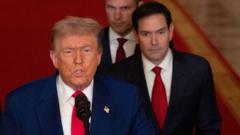The automobile sector faces uncertainty as new tariffs take effect, impacting costs, production, and consumer prices.
Tariffs on Critical Car Parts Take Effect in the U.S.

Tariffs on Critical Car Parts Take Effect in the U.S.
A new 25% import tax on essential car parts adds pressure on the auto industry.
A significant 25% tariff on automotive components, such as engines and transmissions, was implemented in the U.S. early today, further intensifying pressures on an industry already navigating a maze of regulatory adjustments. This import tax follows closely on the heels of a similar 25% duty on automobiles introduced last month, aimed at incentivizing car manufacturers to ramp up production domestically.
Analysts express concern that immediate increases in manufacturing within the U.S. may come at the cost of shifting production overseas, leading to heightened operational expenses and, ultimately, elevated prices for consumers. Interestingly, despite the threat of price hikes, companies have experienced a surge in sales, with both General Motors and Ford reporting a substantial rise in April sales figures.
However, General Motors has cautioned investors about a potential increase in expenses, anticipating up to $5 billion in new costs this year due to the tariffs, which includes an estimated $2 billion in tariffs on vehicles produced in South Korea for U.S. export. As a result, GM revised its price forecasts upward, expecting costs to rise by about 1%.
The tariffs have caused notable volatility, with various automotive companies, including Stellantis—the parent company of Jeep and Fiat—revising their financial outlook, citing ongoing uncertainties. Stellantis' CFO, Doug Ostermann, stated the company is facing "extreme uncertainties."
In the past year, almost half of all vehicles sold in the U.S. were imported. The announcement of the tariffs by former President Trump in March sent significant shockwaves across the automotive landscape, leading to predictions of increased prices and production challenges. Although the president has since relaxed certain aspects of his trade policy, particularly for automotive trade with Canada and Mexico—two vital components of the industry's supply chain—the exemption from tariffs for parts produced in these countries seems more permanent than initially anticipated.
This recent wave of tariff adjustments includes measures to prevent businesses from encountering multiple tariffs on the same products and the establishment of a two-year framework allowing manufacturers to limit their duties on imported components used in U.S.-assembled vehicles.
Stephanie Brinley, a principal automotive analyst at S&P Global Mobility, acknowledged that while recent changes may offer some relief, the market remains dramatically altered. In response to emerging challenges, many manufacturers are exploring ways to bolster U.S. production to mitigate the rising costs, with GM reporting an increase in truck production capabilities in Indiana and potential adjustments in Canadian output.
Experts like Art Wheaton from Cornell University highlighted that while companies may announce plans to increase U.S. production, the likelihood of new factories being built remains low due to economic uncertainties and the considerable investments required. The U.S. government is also actively pursuing trade agreements with key automotive partners such as South Korea and Japan, hinting that further modifications to tariffs could occur if adverse economic impacts become evident.
Current indicators suggest that the full ramifications of these tariffs have yet to materialize, leaving the long-term outlook uncertain for the automotive industry in the U.S.





















